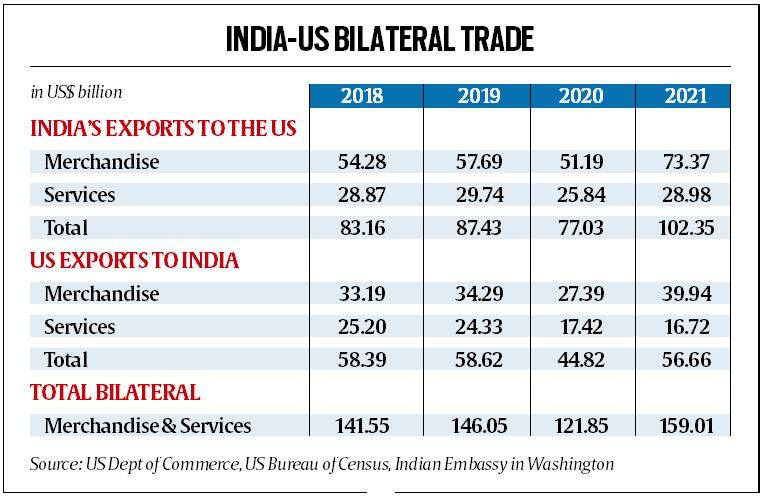Description

Disclaimer: Copyright infringement not intended.
Context: Upcoming state visit of Indian Prime Minister Narendra Modi to the United States.
Details
- Narendra Modi's official state visit to the United States on the invitation of President Joe Biden.
- Highlighting the bipartisan consensus in Washington on fostering the bilateral relationship.
- Recognition of the visit's significance through the invitation to address a joint meeting of Congress for a second time.
Deepening Economic Engagement:
- Economic engagement as a key aspect of the Indo-US strategic partnership.
- Rapid growth in trade between the two countries, with the US becoming India's largest trading partner.
- Favorable balance of trade position for India and significant investments from American companies in various sectors.
- Importance of the historic Air India-Boeing deal and its impact on job creation.
Strategic Underpinnings:
- The strategic context of the Indo-US relationship, with a focus on countering China's influence.
- The role of the Quadrilateral Security Dialogue (Quad) in enhancing regional security and cooperation.
- The I2U2 partnership between India, Israel, the US, and the United Arab Emirates, emphasizing joint investments and initiatives in key sectors.
- Collaboration on critical and emerging technologies and efforts to diversify the semiconductor supply chain.
Potential Challenges and Areas of Concern:
- Export controls and technology transfer restrictions affecting bilateral trade and technological cooperation.
- Pending trade issues, including visa delays and the revoking of India's trade benefits under the GSP program.
- The need to address the contradiction of India's increasing crude oil imports from Russia while strengthening ties with the US.
- Discussions on India's participation in the trade pillar of the US-led Indo-Pacific Economic Framework (IPEF).
Future Prospects and Opportunities:
- Potential pacts and agreements in the defense sector, with a focus on indigenous manufacturing and technology transfer.
- Nudging India towards joining the trade pillar of the IPEF and exploring avenues for a comprehensive free trade agreement.
- Concerns over India's exclusion from the Minerals Security Partnership (MSP) and potential collaboration in critical mineral supply chains.

About India-US Ties
- Historical evolution of India-US relations from the Cold War era to present-day cooperation.
- Significant milestones, including the establishment of diplomatic ties in 1947 and the signing of the India-US Civil Nuclear Agreement in 2008.
Shared Democratic Values and Interests
- Strong foundation of shared democratic values, pluralism, and commitment to human rights.
- Increasing convergence of interests on regional and global issues, such as counterterrorism, maritime security, and climate change.
Economic Engagement
- Growing economic ties, with the US becoming India's largest trading partner.
- Expansion of bilateral trade, reaching a record value of $191 billion.
- Favorable balance of trade position for India and significant investments from American companies in key sectors, generating job opportunities.
Strategic Partnerships
- Quadrilateral Security Dialogue (Quad):
- Collaborative partnership between India, the US, Australia, and Japan to enhance regional security and promote a free and open Indo-Pacific.
- Focus on countering China's influence and ensuring a rules-based order in the region.
- Defense Cooperation:
- Strengthening defense ties through defense agreements, joint exercises, and technology transfer.
- Potential collaboration in areas such as armament manufacturing, ammunition, and air combat.
- Critical and Emerging Technologies:
- Cooperation in critical and emerging technologies, including space, cybersecurity, and artificial intelligence.
- Efforts to diversify the semiconductor supply chain and reduce strategic dependencies.
Addressing Challenges
- Export Controls and Technology Transfer:
- Resolving export control restrictions that inhibit the free transfer of technology and
- hinder bilateral trade.
- Promoting greater technological collaboration and cooperation in areas of mutual interest.
- Trade Issues and Market Access:
- Addressing trade issues such as visa delays and revoking of trade benefits under the GSP program.
- Encouraging trade liberalization, removing barriers, and fostering a more open investment environment.
Future Prospects and Opportunities
Comprehensive Free Trade Agreement (FTA):
- Exploring the possibility of a comprehensive FTA to further enhance trade and economic cooperation.
- Nudging India towards joining the trade pillar of the US-led Indo-Pacific Economic Framework (IPEF).
- Bilateral trade reached $113 billion in 2021, showing substantial growth.
Defense Collaboration and Indigenous Manufacturing:
- Potential pacts and agreements in the defense sector, promoting indigenous manufacturing and technology transfer.
- Strengthening defense capabilities and fostering defense industry collaboration.
Critical Minerals Partnership:
- Addressing concerns over India's exclusion from the Minerals Security Partnership (MSP).
- Potential collaboration in securing critical minerals supply chains and reducing dependency on China.
Technology Collaboration:
- Cooperation in various technology domains, such as artificial intelligence, quantum computing, and 5G.
- Establishment of joint research and development centers for collaborative technological advancements.
|
PRACTICE QUESTION
Q) Discuss the significance of India-US bilateral trade in fostering economic ties and its impact on the global economy. (150 words)
|

https://indianexpress.com/article/explained/explained-economics/narendra-modi-us-visit-at-the-heart-of-indo-us-ties-economics-strategy-8673554/














